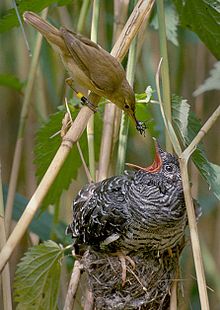Reed Warbler
| Reed Warbler | ||||||||||||
|---|---|---|---|---|---|---|---|---|---|---|---|---|

|
||||||||||||
| Systematics | ||||||||||||
|
||||||||||||
| Scientific name | ||||||||||||
| Acrocephalus scirpaceus | ||||||||||||
| ( Hermann , 1804) |
The Teichrohrsänger ( Acrocephalus scirpaceus ), popularly called Rohrspatz is a bird art of the genus of the warbler ( acrocephalus ) from the family of the tube-like singer (Acrocephalidae).
description
The reed warbler is about 13 cm long and has a wingspan of 17 to 21 cm. The weight is about 10 to 15 grams. The top is brown, its underside yellowish white. The little bird has a whitish throat, a pointed beak and gray-brown legs. Males and females have the same coloration. The flapping frequency of its wings is about 18 beats per second, the flight speed 10 meters per second. A reed warbler can live up to 12 years. His short, inconspicuous call sounds like "Tscharr" and "Tschirrak". Just by appearance, the reed warbler is difficult to distinguish from the reed warbler .
habitat
The reed warbler is a breeding bird of the western and central Palearctic. Another, in part very strongly fragmented, sub-area can be found in the Near East, Central and Central Asia. The distribution ranges from northeast Kazakhstan to northwest Mongolia.
In Central Europe, the long-distance migrant is present from April to October. He has his winter quarters south of the Sahara in Africa . Departure time and direction of movement are innate to him. In order to survive the approximately 6000 kilometers, the night puller builds up fat reserves. The reed warbler lives in the dense reeds and bank bushes of lakes, ponds, moors and rivers.
nutrition
The reed warbler climbs and hops skilfully in the reeds and feeds on spiders , mollusks , insects and their larvae .
Reproduction
Sexual maturity occurs after a year. The main breeding season is May to July. The nest , woven from grass and reed, is mostly attached to the shelter of reed stands between three and four reed stalks above the water. The female lays three to five eggs . The eggs are incubated alternately by both partners for 11 to 14 days. The young birds stay in the nest for 10 to 14 days. It incubates 2 to 3 times a year.
The reed warbler is a frequent cuckoo host who hatches a brood-parasitic cuckoo egg deposited in the nest and raises the alien nestling, to the detriment of its own offspring. In contrast to the reed warbler , which often removes cuckoo eggs from its nest, this behavior has only very rarely been demonstrated in the reed warbler.
Duration
The European population is estimated at around three million breeding pairs.
Others
The reed warbler was Bird of the Year (Germany) 1989 .
literature
- Hans-Günther Bauer, Einhard Bezzel , Wolfgang Fiedler (eds.): The compendium of birds in Central Europe: Everything about biology, endangerment and protection. Volume 2: Passeriformes - passerine birds. Aula-Verlag Wiebelsheim, Wiesbaden 2005, ISBN 3-89104-648-0 .
Web links
- Singing reed warbler at www.vogelstimmen-wehr.de
- Acrocephalus scirpaceus in the endangered Red List species the IUCN 2008. Posted by: BirdLife International, 2008. Accessed January 31 of 2009.
- Videos, photos and sound recordings of Acrocephalus scirpaceus in the Internet Bird Collection
- Age and gender characteristics (PDF; 2.3 MB) by Javier Blasco-Zumeta and Gerd-Michael Heinze (English)
- Feathers of the reed warbler
Individual evidence
- ↑ Bauer et al., P. 233.
- ↑ Matthias Glaubrecht: Evolution of a brood parasite. ZEIT Online, June 26, 1987, accessed November 4, 2012 .



